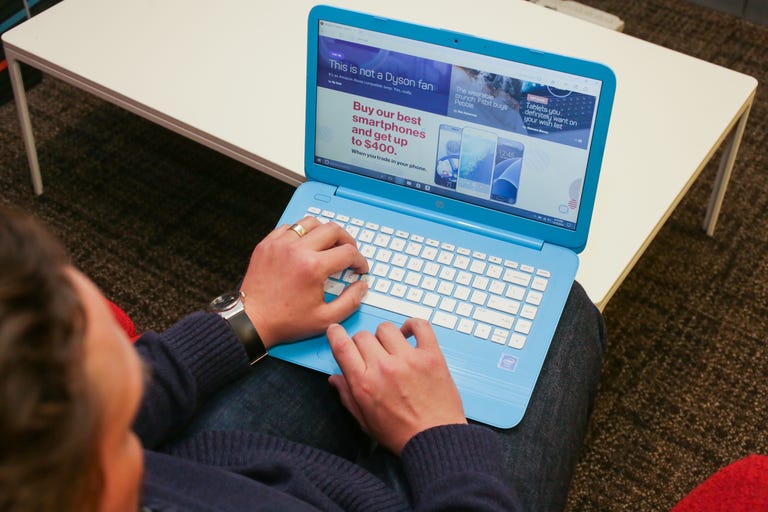 Why You Can Trust CNET
Why You Can Trust CNET HP Stream 14 review: This laptop's best feature is its rock-bottom price
HP once again shows a Windows laptop for email and online apps can be attractive and inexpensive.
A low price on a laptop can make up for a lot of shortcomings. That is, as long as those shortcomings don't interfere with you getting stuff done.
The Good
The Bad
The Bottom Line
The 14-inch HP Stream, for example, is only $220 in the US and £200 in the UK. As long as your needs don't leap too far beyond watching YouTube clips, sending email and using web apps, you're golden. (HP doesn't offer the Stream in a 14-inch size in Australia, but there is the HP 14-am034tu for AU$500, which is similarly configured, but with a 500GB hard drive instead of a 32GB eMMC.)
HP Stream 14 (14-ax010nr)
| Price as reviewed | $220, £200 |
|---|---|
| Display size/resolution | 14-inch 1,366x768 display |
| PC CPU | 1.6GHz Intel Celeron N3060 |
| PC Memory | 4GB DDR3 SDRAM 1,600MHz |
| Graphics | Intel HD Graphics 400 (128MB) |
| Storage | 32GB eMMC storage |
| Networking | 802.11ac, Bluetooth 4.0 |
| Operating system | Window 10 Home (64-bit) |
| Expansion | One USB 2.0 port, Two USB 3.0/3.1 ports, SD card slot, mic/headphone jack, HDMI out |
The 14-inch body is thin and it's light at about 3 pounds (1.4 kg), but if you were hoping for something smaller, HP makes an 11.6-inch Stream for $20 less. It has the same internal components as the 14, but has one less USB 3.1 port and a microSD card slot instead of the 14's full-size slot.
The Stream is a nice-looking laptop, too, assuming you're cool with the bright blue color. It's all plastic with ridges on the lid that give it texture and added grip. The blue continues inside except for the bright white keyboard.
Plenty of ports for peripherals.
With its meager 32GB of storage -- only about half of which is available to use -- it's nice HP didn't skimp on expansion options. An SD card fits almost entirely in the slot, too, so you could easily leave a card in there for files and applications.
You can, of course, use those ports for a keyboard and mouse to avoid the laptop's touchpad and keyboard. The latter isn't altogether unpleasant, but there's very little travel and the keys feel thin and flimsy like they might pop off or stop working if you type too hard. The touchpad is generally OK, but I recommend shutting off most of the multitouch options like pinch-to-zoom and turning up the palm rejection setting.
If you're hooking up a keyboard and mouse, though, you might as well connect a monitor as well. The laptop's screen looks washed out, colors are off and I found myself constantly adjusting the angle in a futile attempt to make it look better. You know what worked? Outputting to a full HD display via HDMI.
As for its stereo speakers, I'll just say there's a headphone jack and Bluetooth 4.0 for a reason and leave it at that.
The touchpad is OK, but turn off a few of its features for optimal performance.
The Stream's advantage over similarly priced and configured Chromebooks is that it's running on Windows 10, so you're not locked into Google's web-based OS. You can install software like Apple's iTunes, Microsoft's Office or Minecraft. The same goes for hardware drivers for mice, keyboards and printers. Oh, and you can use Microsoft's Edge browser or install whatever other browser you want to use including Chrome.
That's not to say you can install and run any Windows software you want on it. It simply doesn't have the processor power or memory to drive anything too demanding. It even struggled with Chrome once it had a half a dozen tabs open (Edge performance was better, though).
While the performance might not blow you away, the battery life is impressive: The Stream 14 ran for 8 hours on our online streaming test. For more simple tasks like word processing, you should be able to hit more than 9 hours.
With the Stream 14, HP once again shows that a Windows laptop for email and online apps can be attractive and inexpensive. It has its issues, but it's $220 and that's hard to argue with.
Multitasking Multimedia Test 3.0 (in seconds)
Geekbench 3 Multi-Core
Online Streaming Battery Drain test (in minutes)
System Configurations
| HP Stream 14 | Microsoft Windows 10 Home (64-bit); 1.6GHz Intel Celeron N3060; 4GB DDR3 SDRAM 1,600MHz; 128MB (dedicated) Intel HD Graphics 400; 32GB eMMC storage |
|---|---|
| HP Stream 11 | Microsoft Windows 10 Home (64-bit); 1.6GHz Intel Celeron N3050; 2GB DDR3 SDRAM 1,600MHz; 144MB (dedicated) Intel HD Graphics; 32GB SSD |
| Lenovo ThinkPad 13 | Microsoft Windows 10 Home (64-bit); 2.3GHz Intel Core i3-6100U; 4GB DDR4 SDRAM 1,600MHz; 128MB (dedicated) Intel HD Graphics 520; 128GB SSD |
| Samsung Galaxy TabPro S | Microsoft Windows 10 Home (64-bit); 0.90GHz Intel m3-6Y30; 4GB DDR3 SDRAM 1,600MHz; 128MB (dedicated) Intel HD Graphics 515; 128GB SSD |
| Microsoft Surface 3 | Microsoft Windows 10 Home (64-bit); 1.6GHz Intel Atom Z8700; 4GB DDR3 SDRAM 1,600MHz; 32MB (dedicated) Intel HD Graphics; 128GB SSD |


